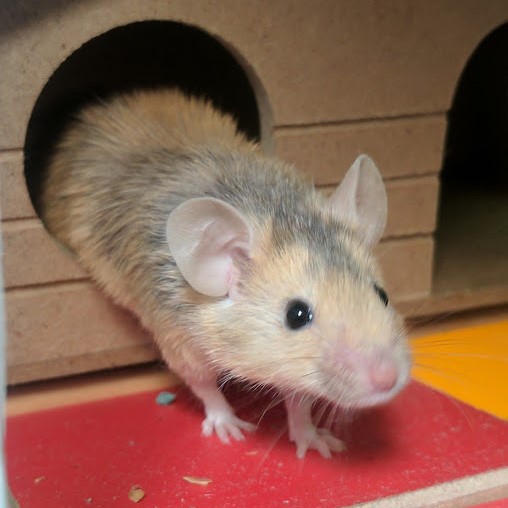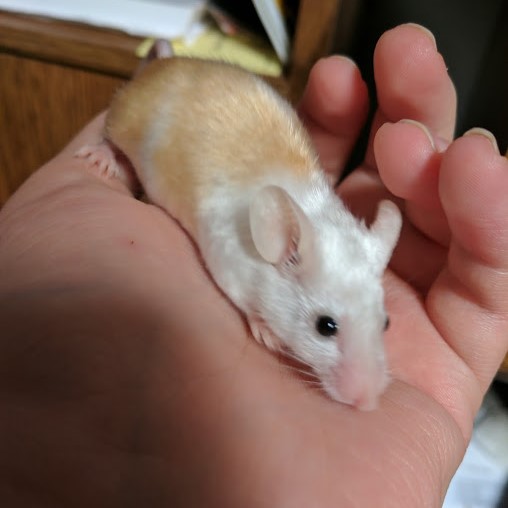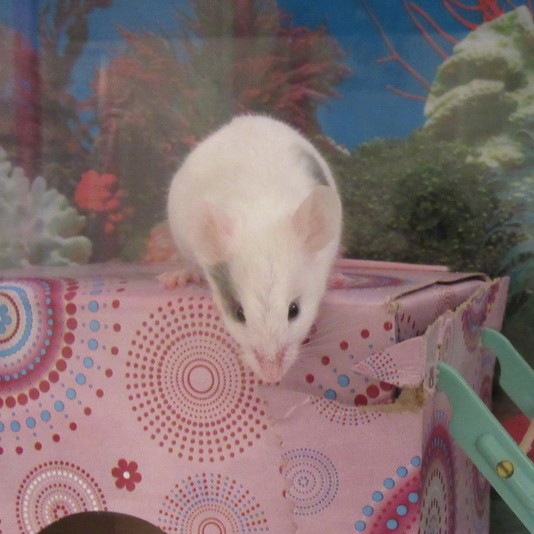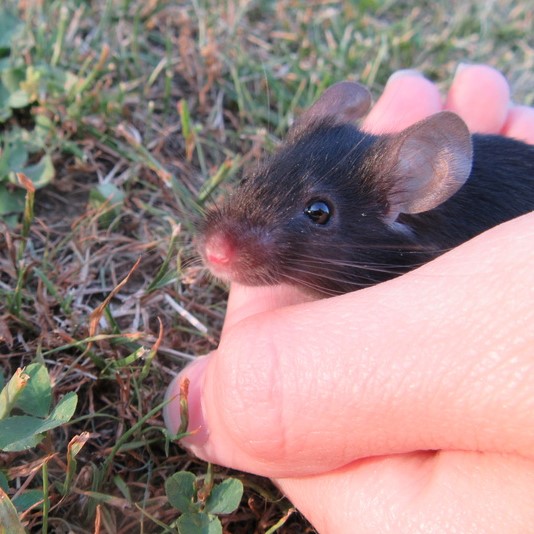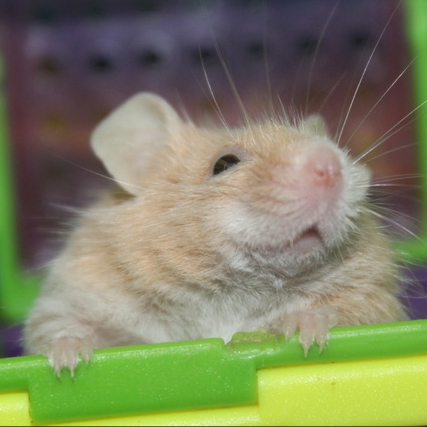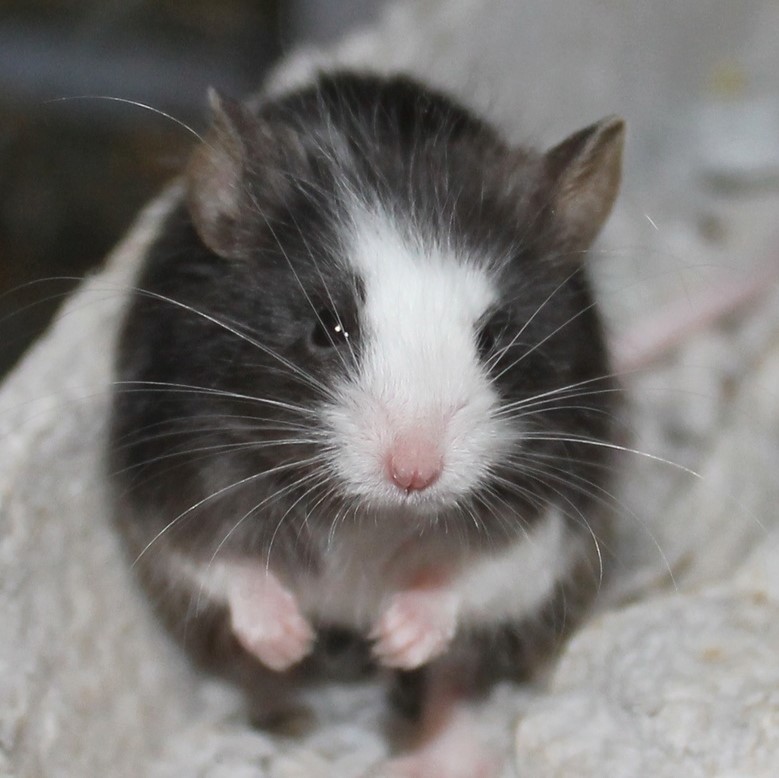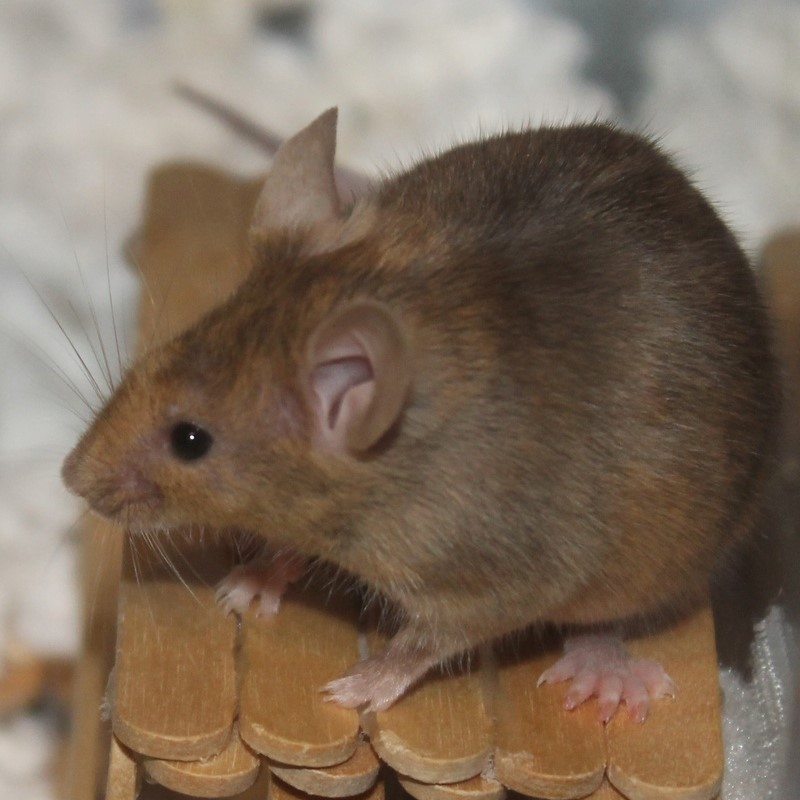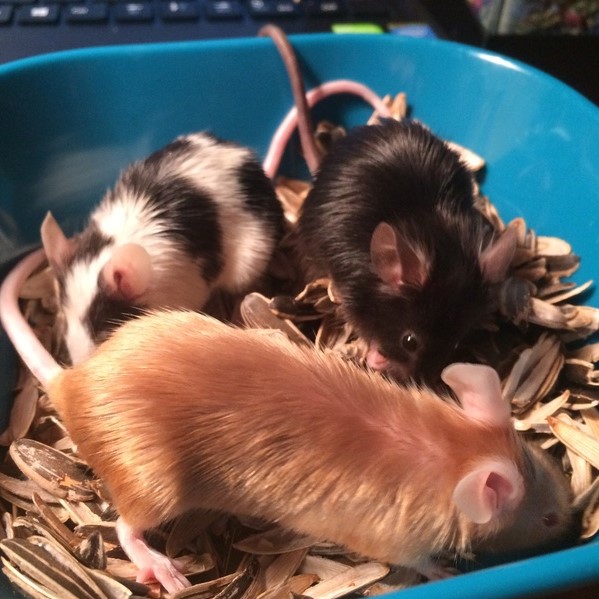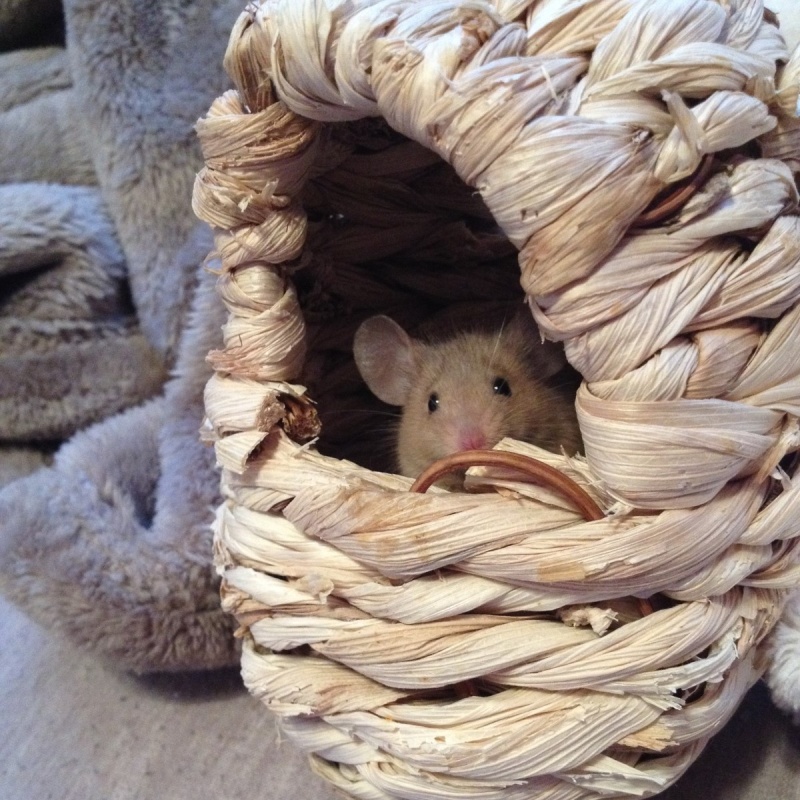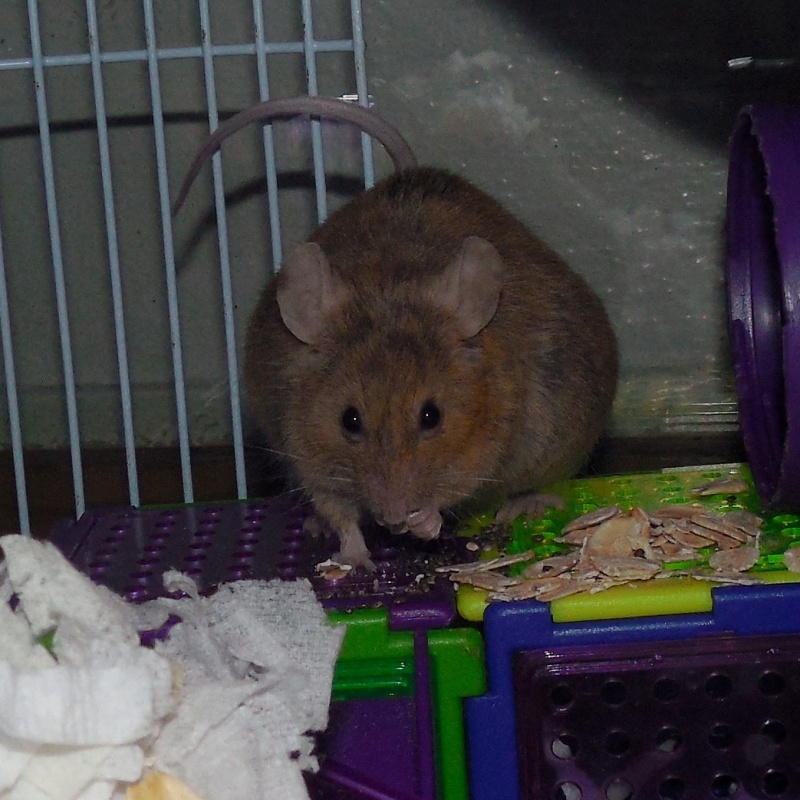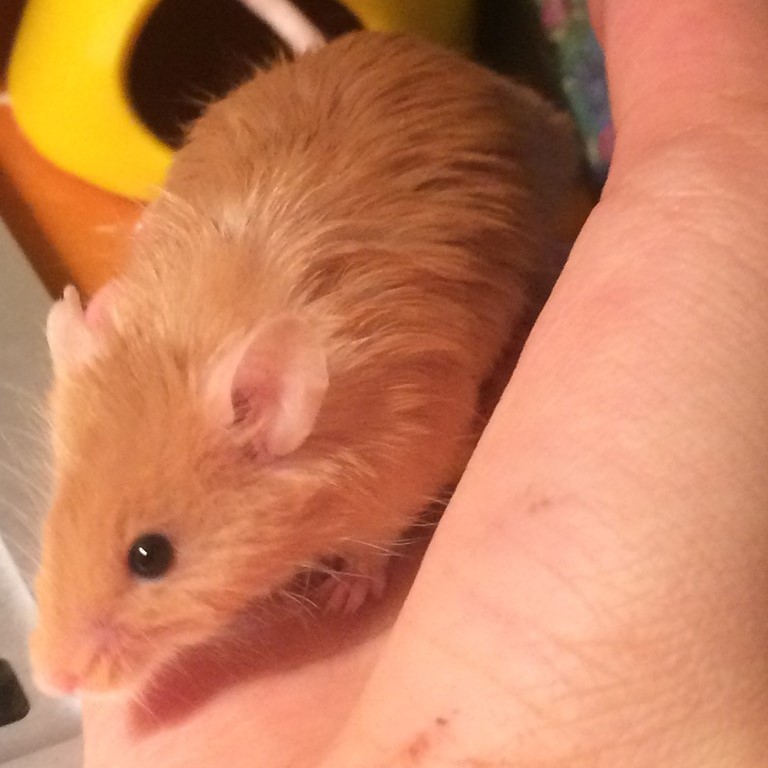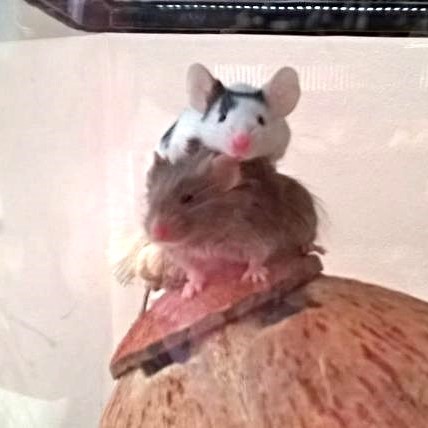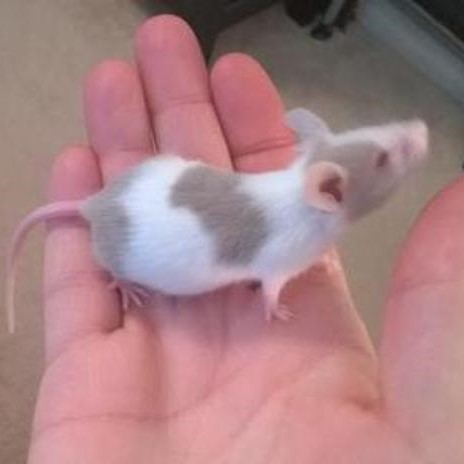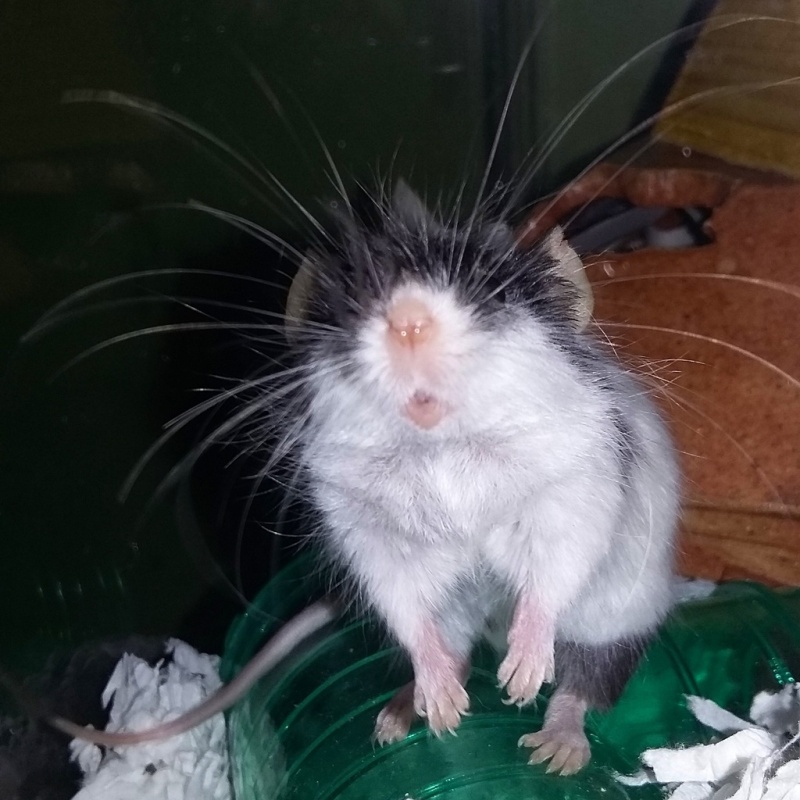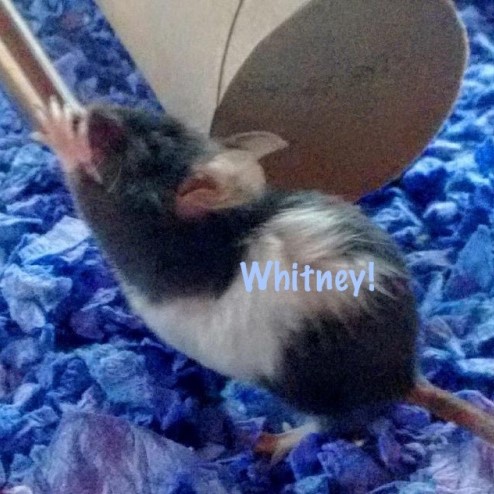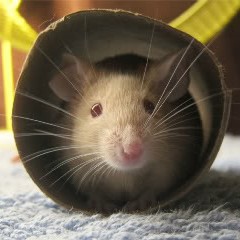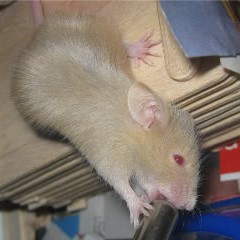Varieties of Mice
Page 1 of 1
 Varieties of Mice
Varieties of Mice
If this page looks a little crazy, please go to your Profile, click preferences, and ensure HTML is on.
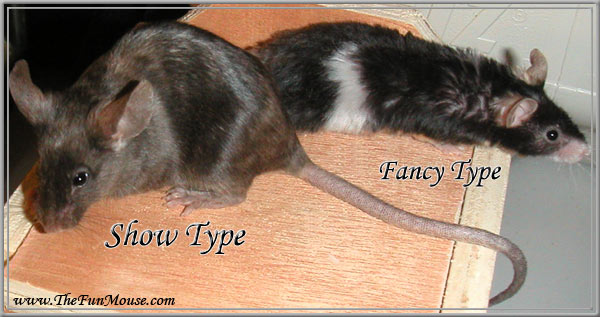
These are both fancy mice, only one has been bred differently than the other. Show type have very large ears, long thick tails, large streamline bodies, and nicely arched backs. Fancy type mice are generally smaller with smaller ears, thinner tails, and little body shape.

Click to see picture larger.
Lab name: Brachyury, Tailless, etc
Genotype: There are too many forms of genes which can cause tailless to mention here. Some are dominant and some recessive. The most common tail modifying gene in the US is believed to be Brachyury T/*. However, this is not meant to cause no tails, just short/half tails. In other countries, such as AU, they have true tailless mice. It is a recessive gene, yet unknown in the mouse community.
Chromosome: 17
Originated: Too many to specify.
Show class: Tailless, where recognized.
General description: Tailless mice should have little to no tail (no tail preferable). If tail is present, it should be free of kinks. Back should be free of abnormalities.

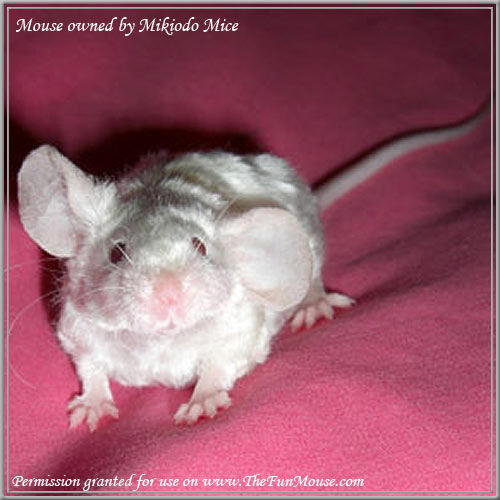
Click to see picture larger.
Lab name: Unknown
Genotype: Unknown. This was once thought to be ld/ld Gremlin/limb deformity, however, there is no sufficient information to back this up.
Chromosome: Unknown
Originated: Unknown
Show class: Not recognized
General description: Gremlin mice should have one ear placed on the side of the head while the other ear is of normal placement.
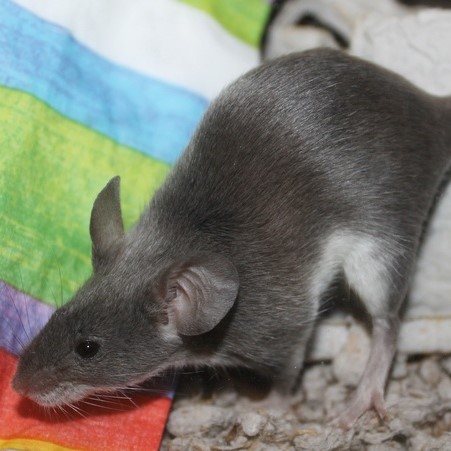
Photo credit to AnonymousMouseOwner.
Lab name: Wild Type
Genotype: Standard is the lack of other coat modifiers.
Originated: Wild
Show class: Standard
General description: Coat should have a high shine, glossy, smooth, thick, short coat.
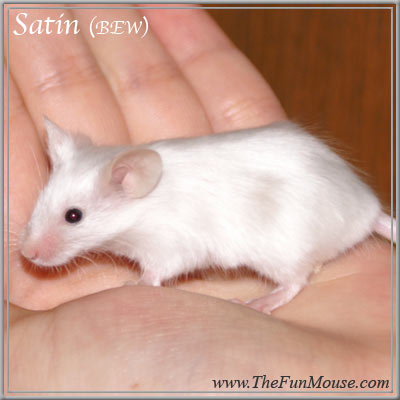
Lab name: Satin
Genotype: sa/sa
Chromosome: 13
Originated: Labs (radiation-induced)
Show class: Satin
General description: Satins have a very silky, soft, dense, and shiny coat. Satin can be harder to see on black mice with an already shiny coat. For black mice, look at the belly of the mouse, as this is where satin will be more apparent.
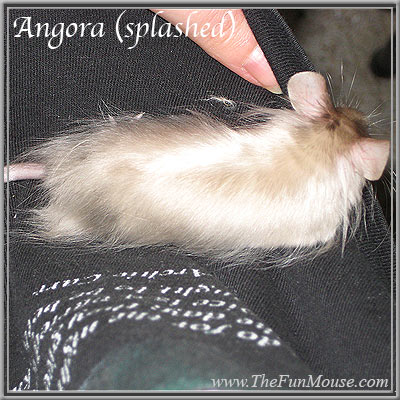
Lab name: Angora
Genotype: go/go
Chromosome: 5
Originated: Labs (deletion)
Show class: Angora or Long Hair
Description: All coat types are longer than normal. Guard hairs are significantly longer. They look and feel wool-like because of the zigzag hairs.
Angoras start showing their long coat around 18 days of age. As they mature, the coat shortens some. Well bred angoras are easily identified at any adult age.
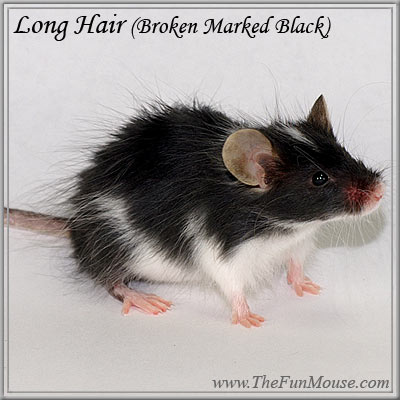
Lab name: Long Hair
Genotype: lgh/lgh
Chromosome: 8
Originated: Spontaneous mutation.
Show class: Angora or Long Hair
General description: Coat should be as long as possible, dense, silky, and smooth. Long haired mice have a standard undercoat, head, feet, and tail.

Lab name: Rex
Genotype: Re/*
Chromosome: 11
Originated: Commercial breeder. Spontaneous mutation.
Show class: Rex or Frizzy
General description: Coat should be tightly woven over the entire body including curly whiskers. Curl should stay well though adulthood. Younger mice usually have better curl.
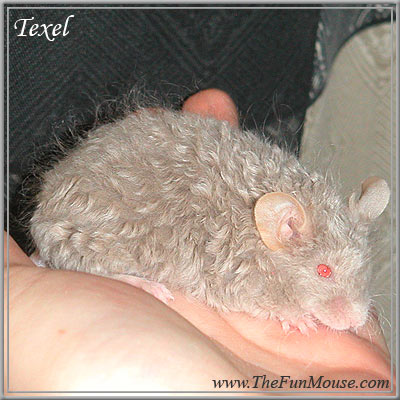
Genotype: Most commonly: Re/* go/go. Also: Rex Re/*, Frizzy fr/fr, or Caracul Ca/* in conjunction with anything that causes longer hair such as: Long hair lgh/lgh or Angora go/go.
Chromosome: Too many to specify.
Originated: Too many to specify.
Show class: Texel or Frizzy
General description: Coat should be long with nice tight curl over the entire body including curly whiskers. Guard hairs should be thickly dispersed over entire coat and curled. Curly hair should stay well through adulthood. Younger mice usually have better curl.
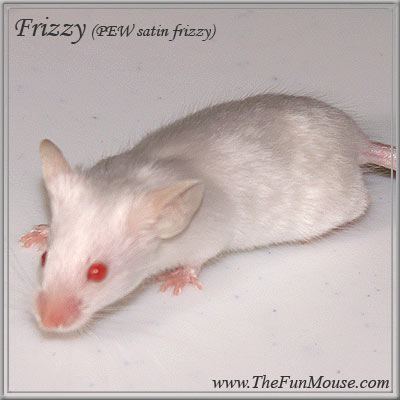
Lab name: Frizzy
Genotype: fr/fr
Chromosome: 7
Originated: Spontaneous mutation at Jackson Laboratory.
Show class: Rex or Frizzy
General description: Frizzy mice generally have little curl, but rather crimped and slightly course hairs. It is significantly harder to breed Frizzy for good curl because of this. However, using Frizzy with other curling genes can greatly enhance curl. Younger mice have better crimp/curl than older mice which may not be identifiable at all.
In the picture shown, it is very hard to see the crimping. Crimping is hard to capture on camera, but can be seen and felt in person. Depending on your monitor, you may or may not see crimping on this mouse.
Note: "Frizzy" is not to be confused with "Frizzy-like" frzl/frzl. Frizzy-like mice have actual curl, resembling rex. They are distinguished from rex due to frizzy-like being recessive. Additionally, rex tends to curl back up in adulthood (though not always) where as frizzy-like does not. Pictures of frizzy-like coats withheld due to the strong resemblance to rex.
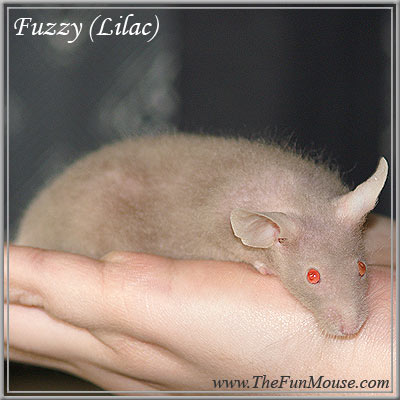
Lab name: Fuzzy
Genotype: fz/fz
Chromosome: 1
Originated: Spontaneous mutation (at Carworth Farms)
Show class: These are shown under Fuzzy, Fuzzy hairless, or hairless depending on how dense the coat is.
General description: Fuzzy can range from no hair at all to very thick and curly coats. Whiskers are crimped or curled.
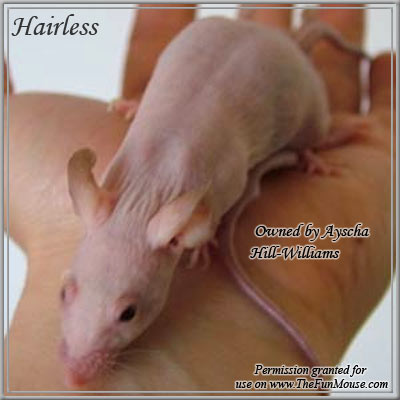
Click to see picture larger.
Lab name: Hairless
Genotype: hr/hr
Chromosome: 14
Originated: Mutation caused by retroviral integration and provirus. (Retroviral: Any of a group of viruses, many of which produce tumors, that contain RNA and reverse transcriptase, including the virus that causes AIDS.)
Show class: Hairless
General description: As hairless as possible (including whiskers) with translucent, bright skin without abrasions or scars. Toe nails should be kept short. Ears should be large.
Note: Hairless mice are NOT "Nude." "Nude" is found on chromosome 11, genotype is nu/nu, they never grow hair (unlike hairless), and usually always die around weaning age.
Genotype: hrrh/hrrh
Chromosome: 14
Originated: Spontaneous allelic mutation
Show class: Not recognized for showing. Some clubs will allow them to be shown in Hairless (they do not penalize wrinkles).
General description: As hairless as possible (including whiskers) with translucent, bright skin without abrasions or scars. Toe nails should be kept short. Ears should be large. Skin should be very wrinkled (their skin resembles a Shar Pei dog).

Click to see picture larger.
Lab name: Rosette
Genotype: rst/rst
Chromosome: unknown
Originated: Spontaneous mutation from English fancy stock.
Show class: Rosette
General description: Rosette mice have a "rosette" on each hip. The rosette causes the fur to look like a whorl with the fur going in a spiral pattern, in the opposite direction as a standard mouses fur.
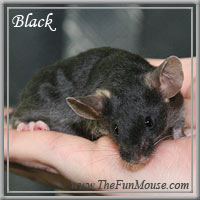
Lab name: Non-agouti
Genotype: a/a
Chromosome: 2
Originated: Spontaneous mutation (however, it has since been made by chemical induction (ethylene oxide) and radiation)
Show class: Black
General description: Jet black with dark eyes. They have yellow hairs in their ears, around genitals, nipples, and base of the tail. A majority of the yellow hairs fall out when the adult coat comes in yet some remain.
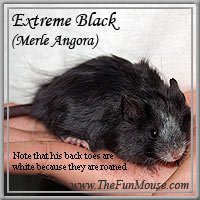
Click to see picture larger.
Lab name: Extreme non-agouti
Genotype: ae/ae
Chromosome: 2
Originated: Spontaneous mutation (mutation was found among descendants of an irradiated mouse).
Show class: Black
General description: Jet black with dark eyes. Extreme black mice lack redness coat color that black mice tend to have. They also completely lack yellow hairs in their ears, around genitals, nipples, and base of the tail.
Black/Extreme Black Comparison
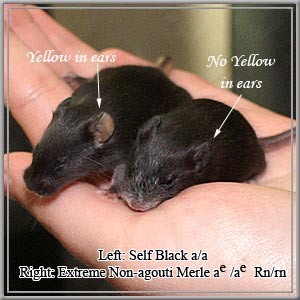

Click to see picture larger.

Lab name: (non-agouti) Brown and/or Cordovan
Genotype: a/a b/b, a/a bc/bc, and a/a bc/b.
Chromosome: bc Cordovan and b Brown are on chromosome 4.
Originated: Brown was a Point mutation. Depending on strain, this mutation was due to radiation, chemical induction, or spontaneous mutation. Cordovan was a spontaneous mutation.
Show class: Chocolate
General description: Dark, rich brown with brown eyes.
It is easier to make a deep rich chocolate using Cordovan than Brown. However, Brown can still give a beautifully deep brown color.

Genotype: a/a cch/ce
Show class: Chocolate
General Description: Dark brown with brown eyes. It can be hard, if not impossible, to visually tell the difference between Mock Chocolate and Chocolate.

Genotype: a/a cch/c
Show class: Chocolate (however, these mice generally will not do good in show as their color is too light).
General description: Light brown with dark eyes.
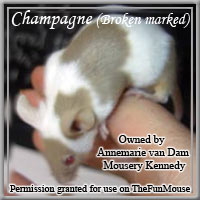
Genotype: a/a b/b p/p
Show class: Champagne
General description: Light brown with a pink tint. Pink eyes
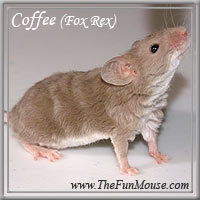
Lab name: (non-agouti) Extreme Dilution
Genotype: a/a ce/ce
Chromosome: Extreme Dilution ce is on chromosome 7.
Originated: Extreme Dilution was found in the wild. (Spontaneous mutation)
Show class: Chocolate (however, these mice generally will not do good in show as their color is too light).
General description: Soft brown with dark eyes.
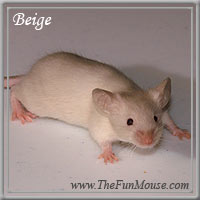
Lab name: (non-agouti) Extreme Dilution
Genotype: a/a ce/ce
Chromosome: Extreme Dilution ce is on chromosome 7.
Originated: Extreme Dilution was found in the wild. (Spontaneous mutation)
General description: Off white, tan-ish with dark eyes.
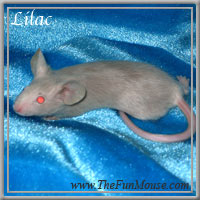
Genotype: a/a p/p
Show class: Lilac (US)
General description: Light blue with a pink tint to the coat. Pink eyes. Lilacs can vary in shade from the mouse you see here to very Silver looking.
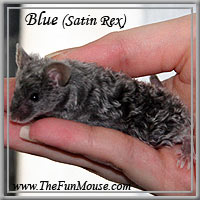

*Note: this description is a combination of 2 different genes, fitting the same variety.
Lab name: (non-agouti) Dilute | Leaden
Genotype: a/a d/d (Dilute) | a/a ln/ln (Leaden)
Chromosome: Dilute: chromosome 9. Leaden: chromosome 1.
Originated: Dilute: Very old mutation first caused by insertion of an ecotropic murine leukemia virus. All other mutations lack the virus. Leaden: Spontaneous mutation (Point mutation)
Show class: Blue
General description: Dark slate blue with dark eyes.
There are several ways to tell the difference between Leaden and Dilute. The most obvious of ways is that Leaden is epistatic to recessive yellow e/e, whereas Dilute is not. Additionally, when Leaden is present with other modifying genes on different loci, they often have a lighter phenotype than Dilute does when combined with the same modifying genes.

Genotype: a/a d/d p/p
Show class: Silver
General description: Light silver-gray, much like chrome, with pink eyes.
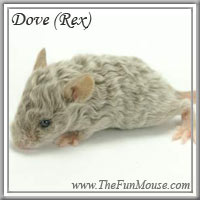
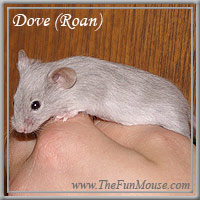
Genotype: a/a b/b d/d
Show class: Dove (US)
General description: An even mix of blue and chocolate with dark eyes.
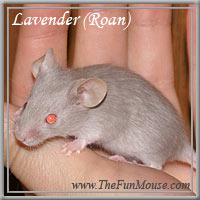
Genotype: a/a b/b d/d p/p
Show class: Lavender
General description: Lavender is a mix between Champagne and Silver. Pink eyes.
Note: The mouse pictured here should ideally have more silver tones to her. Non-satin doesn't show silver tones as well as satin. Roan also bleaches the color a little, making her a bit light. She is lavender though, but to the light end of the variety. She's from a litter consisting of black, blue, chocolate, champagne, lilac, dove (such as the dove roan above), and lavender.
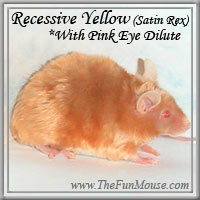
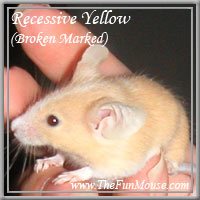


Lab name: (non-agouti) Recessive Yellow
Genotype: a/a e/e
Chromosome: recessive yellow is on chromosome 8
Originated: Spontaneous mutation. This mutation is a frameshift caused by a deletion of one nucleotide.
Show class: Gold, Fawn, Orange, or Red depending on shade of coat and eye color.
General description: These mice can come in any number of yellow shades ranging from flame red, light blond, and even dark sable-looking. Their appearance can be hard to tell apart from Lethal Yellow. However, recessive yellow mice are very different genetically. In youth, recessive yellow mice are usually sooty, having uneven color, often with dark ticking (often being more prevalent over the rump). This usually goes away with their adult coat.
Recessive Yellow mice can have any color eyes. Pink eyed recessive yellow mice tend to be more flame red while dark eyed recessive yellow mice tend to be more blond or "sable" in appearance.
Recessive Yellow, when combined with spotting genes, causes reduced white spotting. [/h3]


Lab name: Yellow
Genotype: AY/* (Note: AY/AY is lethal.)
Chromosome: 2
Originated: Old mutation originating from non-commercial fanciers.
Show class: Red, Fawn, Orange depending on shade.
General description: Much like Recessive yellow, lethal yellow can come in a wide range of colors, therefore they can be shown in a wide range of classes. Lethal Yellow, when combined with spotting genes, causes reduced white spotting.
Health: Lethal Yellow mice are more susceptible to an array of health abnormalities. They are models for Diabetes because of their abnormal insulin levels. They have a higher instance of food allergies than most other varieties. They are also prone to obesity, which leads to many other health problems. Weight gain generally starts after 10 weeks of age. Even with an adjusted diet and increased exercise it's hard, if not impossible in many cases, to control their weight. Weight gain causes low fertility, therefore breeders tend to breed females younger than they may breed other varieties (but still not before acceptable breeding age). These mice are also far more susceptible to tumors. Note that this does NOT mean that all Lethal Yellow mice will have these problems. These mice just need to be thoroughly screened for health problems. Careful breeding needs to be done. It is not recommended to obtain a Lethal Yellow mouse from anywhere other than a *good* breeder, even if you don't intend to breed.
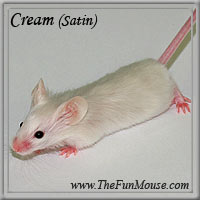
Genotype: AY/* cch/cch OR Ay/* b/b d/d OR a/a ce/c, among other genotypes.
Show class: Cream
General description: Cream mice are very light creamy-yellow color. Dark eyes

Lab name: Albino (c/c)
Genotype: c/c (Note: Albino is always c/c, but there are several ways to make PEW.)
Chromosome: 7
Originated: Very old spontaneous mutation dating back to Greek and Roman times. (Point mutation)
Show class: PEW
General description: pure white with pink eyes

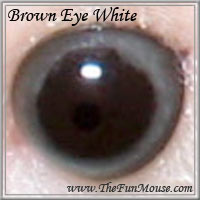
Genotype: There are *many* ways to make a BEW.
Show class: BEW
General description: Pure white coat with dark eyes. Contrary to popular belief, BEW mice do NOT have black eyes, no matter the color of the mouse. Most mice actually have brown eyes.
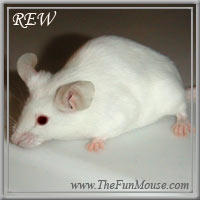
Lab name: Ruby-eyed (this is Ruby Eyes only, not coat color)
Genotype: ru/ru is one of the many genotypes for ruby eyes. This has little to do with the white coat, however. Ruby eyes will dilute the coat, but not to an extreme. The white coat is likely due to c-dilutes (with ruby eyes diluting the coat further to white) or excessive spotting.
Chromosome: There are many ruby eye alleles on several different chromosomes.
Originated: Spontaneous mutation found in silver piebald stock.
Show class: REW (Ruby Eye White)
General description: Pure white coat with deep ruby eyes. Not to be confused with BEW. Eye color is best seen in good lighting.

Lab name: Black and Tan
Genotype: at/*
Chromosome: 2
Originated: Spontaneous mutation (first found in English fancy stock)
Show class: Tan
General description: Tan have a dark golden-red tan on the underside. Tan should have a distinct line where the top color meets the bottom (tan) color. The line should run as straight as possible down its sides, chest, and jaw. Tan hairs behind ears or straying up from the mouses underside is a fault in show standards. Tans can be shown in any color with eyes to match.

Genotype: Fox can be made in a number of ways. It can also be combined with most colors and patterns. Here is a basic highlight (starting point) of these. Note that there will always be more than I can possibly outline here.
Show class: Fox
General description: Fox is similar to Tan, except the tan belly is white in color. A creamy belly is not desirable.
Fox can also come in most other colors and patterns, noting that shades will very depending on what c-dilutes you use.
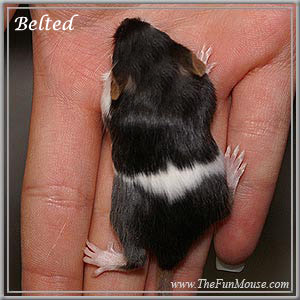
Lab name: Belted
Genotype: bt/bt
Chromosome: 15
Originated: Spontaneous mutation (Point mutation)
Show class: Belted mice are usually shown in the Banded class. Genetically belted mice often make the best examples of Banded in show.
General description: Belted mice resemble banded mice with a band around their mid-section. Opposite to Banded, the white band on a Belted mouse starts on the back and is usually thicker on the back. The white band then goes down the sides of the mouse and around the belly. Belted mice generally have a thinner stripe on the belly, in comparison to the back. However, they can be bred to have the most perfect, even, band.

Double Banded Black (colored bands "should" span all the way around mouse, unlike this one)
Lab name: Banded
Genotype: Wbd/*
Chromosome: Banded is found on chromosome 5.
Originated: Spontaneous mutation
Show class: Banded
General description: Solid mouse with a white band completely around the midsection. White band if usually wider and starts on the belly. The white band then goes up the back. Good banded mice will have an clean, even band all the way around. However, some will have broken bands, not connecting at the spine or only going half way around the mouse. The band is often covering the mouses' belly entirely or close to it (considered a fault). Band can also be extremely wide, consuming 1/2 of the mouse. Banded can also cause 2 white bands around the mouse, often referred to as Double Banded. Double banded often occurs in homozygous banded mice (Wbd/Wbd)
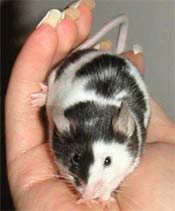
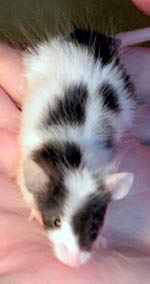
Pictured from left to right : Broken black, Even Marked Black (this isn't the best example of Even Marked but close. Spots should completely mirror each other. This mouse has very small faults)
Lab name: Piebald
Genotype: s/s
Chromosome: 14
Originated: Spontaneous mutation (very old mutation, dating back to around the 1920's)
Show class: Piebald can look like many show classes depending on spotting pattern;
General description: Piebald is often referred to as "cow marked" (slang) because of its tendency to distribute cow-like markings. However, they can mimic a lot of different spotting genes.
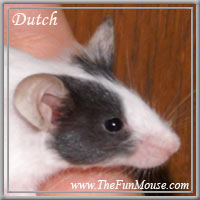
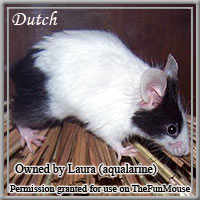
Ideally, the saddle (black rump marking) should consume more of the body and be cleaner cut. The face marking should be rounded better and go around the back of the ear as well.
Lab name: Unknown
Genotype: Unknown. Some fanciers believe there is a gene which causes the dutch pattern while others believe that it's one or a combination of: piebald, banded, sashed, and/or belted.
Chromosome: Unknown
Show class: Dutch
General description: Markings include: oval shaped patch starting at the front of the eye and going to the back of the ear on both sides of the face. This marking should not touch the whiskers. A white stripe should be apparent, yet very narrow, between the dark face markings starting at the nose and going around the ears. They should also be marked from the hips back, leaving the front half of the mouse white. Spots should be clean cut. Dutch can come in any color.


Lab name: Dominant Spotting
Genotype: W/w (Note: that W/W is lethal.)
Chromosome: 5
Originated: Very old spontaneous mutation (point mutation)
Show class: Variegated
General description: White spots should be very jagged and spread throughout the coat. Variegated can come in any color with eyes to match. Variegated should not be confused with Splashed. Splashed is color on color where as variegated is a spotting pattern, white spots on a colored mouse.
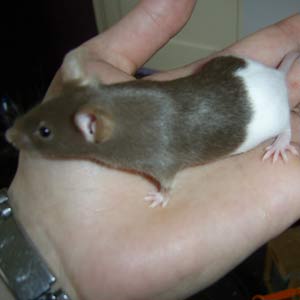
Owned by Annemarie van Dam, Mousery Kennedy and bred by Mousery Narbo-Huan
Ideally, the rump line should be cleaner cut than this mouse.
Lab name: Rump White
Genotype: Rw/* (Note: Rw/Rw is lethal.)
Chromosome: 5
Originated: Radiation induced (Inversion)
Show class: Rump White
General description: Colored mouse with white rump. White spotting covers the front of the hips, all the way back including the tail. The line breaking the spotting and colored part of the mouse should be well defined and even all the way around mouse including the belly.

Genotype: These mice are highly likely a result of "bad" distribution of other spotting genes (likely resulting when combining more than one spotting gene which sometimes causes PEW, BEW, and highly over spotted mice of varying patterns such as this).
Chromosome: see other spotting genes.
Show class: None at the present time. Good examples of these mice are hard to find and reproduce.
General description: Rump Black/Colored Rump is the exact opposite of Rump White. Colored Rump mice should have a colored rump, from hips to tail, with the entire top of the body white. Line should be well defined and even all the way around mouse.

Lab name: See Splashed and spotting genes.
Genotype: See Splashed and spotting genes
Show class: Tri Color
General description: Tri colors consist of 3 "visual" colors, patched evenly throughout the mouse. Each "visual" color should cover 1/3 of the mouse in even patches. Tri colors should look as if the patches are over lapping and be well defined. Tricolors can come in many different colors with eyes to match. Tri colors are not to be confused with Spotted Tans.


Lab name: Agouti (often referred to as "Wild type")
Genotype: A/*
Chromosome: 2
Originated: wild.
Show class: Agouti
General description: The coat is golden tan with a slate blue under color. The top of the mouse tends to be much darker than the sides and belly. Eye color is dark.
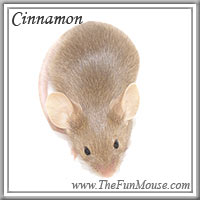
Genotype: A/* b/b
Show class: Cinnamon
General description: Similar to the agouti but with more chocolate coloring. The black in an agouti is replaced with Chocolate on a cinnamon mouse. Dark eyes.
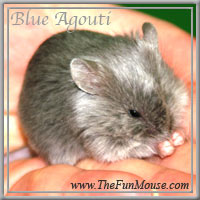

Genotype: A/* d/d
Show class: Blue Agouti
General description: Coat is blue and Agouti with dark eyes. Base of hairs are dark blue, the middle of the hair is blue, and the tips are a white color.
*Blue agouti's can range in color and take very selective breeding to eliminate brown tones. Sometimes the agouti in the coat shows through more than the blue, making a blue agouti look very similar to Dove (US Dove).


Genotype: A/* d/d p/p
Show class: Silver Argenté is not recognized at this time.
General description: Each hair should have bands of: slate blue undercoat, silver middle, and white tips.
*Silver Argenté's can range in color and take very selective breeding to eliminate brown tones.
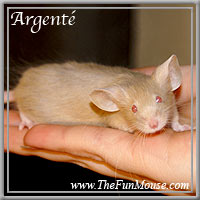

Genotype: A/* p/p
Show class: Argenté
General description: Yellow in color with a lilac under color. Pink eyes. As fuzzies these babies can easily be mistaken for other yellow color varieties as the lilac under color doesn't come in until the fur grows longer.

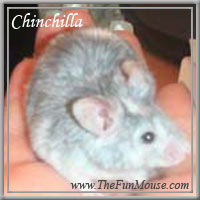
Lab name: Chinchilla
Genotype: A/* cch/cch or Aw/* cch/cch
Chromosome: cch Chinchilla is on chromosome 7.
Originated: cch Chinchilla was originally from non-commercial fancier stock (point mutation)
Show class: Chinchilla
General description: Each hair should have a blue base, gray middle, and black tips. Belly to be fox. Dark eyes.
Note: Some clubs only allow chinchilla to be shown if the mouse is Fox A/at or Aw/*, not just homozygous chinchilla. The genetics information above is only based on the Chinchilla allele cch/cch as specified. Refer to agouti and tan (chinchilla dilutes tan to "fox") for genetics information on those.
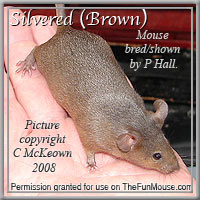
Lab name: (non-agouti) Silver
Genotype: a/a si/si
Chromosome: The Silver gene is located on chromosome 10
Originated: Spontaneous mutation originally found in English fancier stock.
Show class: Silvered
General description: Coat has hairs consisting of; all white (completely lacking pigmentation), full colored (such as black), colored hairs with white tips, and hairs with several white and colored bands (some colored bands diluted in color). Well bred Silvered mice will have pure silver hairs (no color from base to tip) spread thick and evenly throughout the coat. Colored hairs should hold rich color through the individual hair. Silvered mice can come in any color. However, some clubs only recognize some colors and the interaction with other markings can be undesirable. Males often show more silvering than females. Silvered is not to be confused with roan or chinchilla, although they can look very similar.
 " />
" />
Lab name: Viable Yellow
Genotype: Avy/*
Chromosome: 2
Originated: Spontaneous mutation (transposon insertion)
Show class: Brindle
General description: Stripped similar to a tiger from head to tail. Less define stripes on the belly.
These brindles are genetically linked to obesity, therefore they are more prone to health problems caused by the extra weight such as heart issues, diabetes, infertility, shortened life span, among many other conditions. These brindles are more prone to food allergies and tumors as well. Brindles are among of the number one choice (along with hairless) for labs to use in cancer research because of how well they 'accept' and 'grow' tumors. This does NOT mean they 'will' have the problems mentioned, they are just more prone to them than most other varieties. It is very important to obtain this variety from a GOOD breeder as that will greatly help prevent these problems. Brindles from bad breeders, including pet shops, are MUCH more likely to suffer health issues.
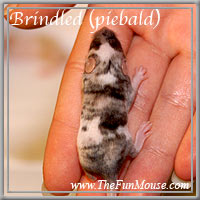
Note that the white spotting on the mouse pictured is piebald s/s and NOT a part of the brindled pattern.
Lab name: (non-agouti) Brindled
Genotype: a/a Mobr/* Note that Brindled is Sex linked. Homozygous Brindled is lethal as well as brindled bucks.
Chromosome: Brindled is on the X chromosome.
Originated: Spontaneous mutation (point mutation)
Show class: Brindle
General description: Striped similar to a tiger from head to tail. Less define stripes on the belly. They can be any color with eyes to match. Stripes on English brindles usually get wider with age.
These Brindled mice do not have the same health issues as Brindle (description above). The health of the females is the same as any other mouse. They are, however, sex linked. This means that outside of a lab, only females survive. Males suffer from copper deficiency, anemia. They appear similar to himalayan mice, with points. However, these points are part of their skin (where as a himalayan has pointed fur, not skin). They also tend to have extremely curly (spiral) whiskers regardless of coat type.

Lab name: (non-agouti) Roan or Roan Freckled
Genotype: a/a Rn/* and/OR a/a Rnfkl/*
Chromosome: 14
Originated: Both were Spontaneous mutations in lab stock. Roan was first found in gremlin stock while Freckled was first found in stock carrying t-alleles.
Show class: Roan
General description: Coat is a mixture of white hairs and any other color which is evenly distributed throughout the body. Eyes should match the body color. Some roans have more white hairs on their belly (making them appear almost fox-like) while others do not. The roan gene tends to dilute the base color of the mouse (i.e. a black mouse will often be 'off black', sometimes almost blue in appearance).

Genotype: Unknown. It is believed to be a modifier of roan or another gene which is stopping the roaning in areas, leaving solid patches (much like how the splashed gene stops c-dilute in areas).
Chromosome: Unkown
Originated: Unkown
Show class: Merle
General description: Coat is marble-like in pattern. Lighter roan body with distributed patches of a solid color. Eyes to match the base color. Roans should not be mistaken with white spotted mice or splashed. (also read Roan, above)

Genotype: a/a ch/c
Show class: Himalayan
General description: White body with define dark points on the nose, ears, feet, and tail. Pink eyes.

Genotype: a/a ce/ch
Show class: Color Point beige
General description: Color Point beige look similar to Himalayan with dark points on their nose, ears, feet and tail, but they also have dark eyes and an off white (creamy) body.
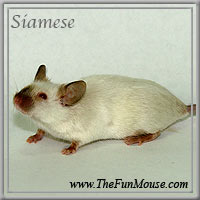
Lab name: (non-agouti) Himalayan
Genotype: a/a ch/ch
Chromosome: The Himalayan allele is on chromosome 7.
Originated: Spontaneous mutation (Point mutation)
Show class: Siamese
General description: Similar to the Himalayan but with larger points and creamy body shading. Ruby eyes.
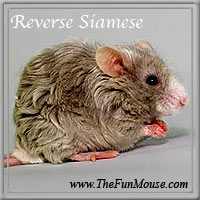
Genotype: Unknown
Chromosome: Unknown (likely having to do with extreme dilute ce)
Originated: Unknown
Show class: Reverse Siamese
General description: Any color mouse with bright white points at the nose, ears, feet, and tail. Reverse Siamese are usually (possibly always) coffee with white points.
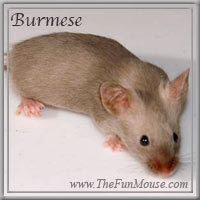
Genotype: a/a cch/ch
Show class: Burmese, Siamese Sable
General description: Burmese can come in almost any color with dark points at the mouses nose, feet, and tail. Points are the same color as the body, just darker. Burmese can vary in shade from dark chocolate (making the points indefinable) to light brown with dark points.
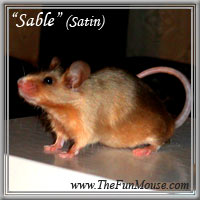
The Sable pictured here is not a "true" sable, genetically. She does, however, possess an amazing likeness to a true sable. She is recessive yellow genetically.
Lab name: Yellow, Tan, Umbrous-Patterned
Genotype: Ay/at Up/*
Chromosome: At the present time, the chromosome Umbrous-Patterned is located on is unknown.
Originated: Spontaneous mutation (First discovered in a Peru stock mouse with high frequency of non-pairing of the sex chromosomes, after introduction of the yellow allele Ay)
Show class: Sable
General description: Mouse should have a dark back fading into a red-ish-tan underside.


Genotype: Unknown. Speculation is that splashed is transgenic.
Chromosome: Unknown
Originated: Unknown
Show class: Splashed
General description: Coat has darker splashes of color on a colored mouse. Splashed can come in any color with eyes to match. Splashed is not to be confused with Variegated, Brindle, or Brindled. Some forms of Splashed can be indistinguishable from Brindled and Brindle to the eye (such as lilac forms of each as well as, though not limited to, CP Beige Brindled and Brindle).
On this page:
- Body Types
- Coat Types
- Self Colors
- Tan and Fox
- Marked
- Other Colors
- Other Color Patterns
- Learn more about Tri-Color!
Body Type
Show Type & Fancy Type

These are both fancy mice, only one has been bred differently than the other. Show type have very large ears, long thick tails, large streamline bodies, and nicely arched backs. Fancy type mice are generally smaller with smaller ears, thinner tails, and little body shape.
English mice
English mice are also fancy mice and can have the body type of fancy mice or show mice. All English means is that the mouse has English blood in it.Tailless

Click to see picture larger.
Lab name: Brachyury, Tailless, etc
Genotype: There are too many forms of genes which can cause tailless to mention here. Some are dominant and some recessive. The most common tail modifying gene in the US is believed to be Brachyury T/*. However, this is not meant to cause no tails, just short/half tails. In other countries, such as AU, they have true tailless mice. It is a recessive gene, yet unknown in the mouse community.
Chromosome: 17
Originated: Too many to specify.
Show class: Tailless, where recognized.
General description: Tailless mice should have little to no tail (no tail preferable). If tail is present, it should be free of kinks. Back should be free of abnormalities.
Gremlin


Click to see picture larger.
Lab name: Unknown
Genotype: Unknown. This was once thought to be ld/ld Gremlin/limb deformity, however, there is no sufficient information to back this up.
Chromosome: Unknown
Originated: Unknown
Show class: Not recognized
General description: Gremlin mice should have one ear placed on the side of the head while the other ear is of normal placement.
Coat Types
- Standard/Shorthair
- Satin
- Angora
- Longhair
- Rex
- Caracul
- Texel
- Frizzy
- Fuzzy/Fuzzy Hairless
- Hairless
- Rhino Hairless
- Rosette
Standard/Shorthair

Photo credit to AnonymousMouseOwner.
Lab name: Wild Type
Genotype: Standard is the lack of other coat modifiers.
Originated: Wild
Show class: Standard
General description: Coat should have a high shine, glossy, smooth, thick, short coat.
Satin

Lab name: Satin
Genotype: sa/sa
Chromosome: 13
Originated: Labs (radiation-induced)
Show class: Satin
General description: Satins have a very silky, soft, dense, and shiny coat. Satin can be harder to see on black mice with an already shiny coat. For black mice, look at the belly of the mouse, as this is where satin will be more apparent.
Angora

Lab name: Angora
Genotype: go/go
Chromosome: 5
Originated: Labs (deletion)
Show class: Angora or Long Hair
Description: All coat types are longer than normal. Guard hairs are significantly longer. They look and feel wool-like because of the zigzag hairs.
Angoras start showing their long coat around 18 days of age. As they mature, the coat shortens some. Well bred angoras are easily identified at any adult age.
Longhair

Lab name: Long Hair
Genotype: lgh/lgh
Chromosome: 8
Originated: Spontaneous mutation.
Show class: Angora or Long Hair
General description: Coat should be as long as possible, dense, silky, and smooth. Long haired mice have a standard undercoat, head, feet, and tail.
Rex

Lab name: Rex
Genotype: Re/*
Chromosome: 11
Originated: Commercial breeder. Spontaneous mutation.
Show class: Rex or Frizzy
General description: Coat should be tightly woven over the entire body including curly whiskers. Curl should stay well though adulthood. Younger mice usually have better curl.
Texel

Genotype: Most commonly: Re/* go/go. Also: Rex Re/*, Frizzy fr/fr, or Caracul Ca/* in conjunction with anything that causes longer hair such as: Long hair lgh/lgh or Angora go/go.
Chromosome: Too many to specify.
Originated: Too many to specify.
Show class: Texel or Frizzy
General description: Coat should be long with nice tight curl over the entire body including curly whiskers. Guard hairs should be thickly dispersed over entire coat and curled. Curly hair should stay well through adulthood. Younger mice usually have better curl.
Frizzy

Lab name: Frizzy
Genotype: fr/fr
Chromosome: 7
Originated: Spontaneous mutation at Jackson Laboratory.
Show class: Rex or Frizzy
General description: Frizzy mice generally have little curl, but rather crimped and slightly course hairs. It is significantly harder to breed Frizzy for good curl because of this. However, using Frizzy with other curling genes can greatly enhance curl. Younger mice have better crimp/curl than older mice which may not be identifiable at all.
In the picture shown, it is very hard to see the crimping. Crimping is hard to capture on camera, but can be seen and felt in person. Depending on your monitor, you may or may not see crimping on this mouse.
Note: "Frizzy" is not to be confused with "Frizzy-like" frzl/frzl. Frizzy-like mice have actual curl, resembling rex. They are distinguished from rex due to frizzy-like being recessive. Additionally, rex tends to curl back up in adulthood (though not always) where as frizzy-like does not. Pictures of frizzy-like coats withheld due to the strong resemblance to rex.
Fuzzy/Fuzzy Hairless

Lab name: Fuzzy
Genotype: fz/fz
Chromosome: 1
Originated: Spontaneous mutation (at Carworth Farms)
Show class: These are shown under Fuzzy, Fuzzy hairless, or hairless depending on how dense the coat is.
General description: Fuzzy can range from no hair at all to very thick and curly coats. Whiskers are crimped or curled.
Hairless

Click to see picture larger.
Lab name: Hairless
Genotype: hr/hr
Chromosome: 14
Originated: Mutation caused by retroviral integration and provirus. (Retroviral: Any of a group of viruses, many of which produce tumors, that contain RNA and reverse transcriptase, including the virus that causes AIDS.)
Show class: Hairless
General description: As hairless as possible (including whiskers) with translucent, bright skin without abrasions or scars. Toe nails should be kept short. Ears should be large.
Note: Hairless mice are NOT "Nude." "Nude" is found on chromosome 11, genotype is nu/nu, they never grow hair (unlike hairless), and usually always die around weaning age.
Rhino Hairless
Lab name: Rhino HairlessGenotype: hrrh/hrrh
Chromosome: 14
Originated: Spontaneous allelic mutation
Show class: Not recognized for showing. Some clubs will allow them to be shown in Hairless (they do not penalize wrinkles).
General description: As hairless as possible (including whiskers) with translucent, bright skin without abrasions or scars. Toe nails should be kept short. Ears should be large. Skin should be very wrinkled (their skin resembles a Shar Pei dog).
Rosette

Click to see picture larger.
Lab name: Rosette
Genotype: rst/rst
Chromosome: unknown
Originated: Spontaneous mutation from English fancy stock.
Show class: Rosette
General description: Rosette mice have a "rosette" on each hip. The rosette causes the fur to look like a whorl with the fur going in a spiral pattern, in the opposite direction as a standard mouses fur.
Self Color Types
- Black
- Extreme Black
- Chocolate
- Mock Chocolate
- Light Mock Chocolate
- Champagne
- Coffee
- Beige
- Lilac
- Blue
- Silver
- Dove
- Lavender
- Recessive Yellow
- Lethal Yellow
- PEW
- BEW
- REW
Black

Lab name: Non-agouti
Genotype: a/a
Chromosome: 2
Originated: Spontaneous mutation (however, it has since been made by chemical induction (ethylene oxide) and radiation)
Show class: Black
General description: Jet black with dark eyes. They have yellow hairs in their ears, around genitals, nipples, and base of the tail. A majority of the yellow hairs fall out when the adult coat comes in yet some remain.
Extreme Black

Click to see picture larger.
Lab name: Extreme non-agouti
Genotype: ae/ae
Chromosome: 2
Originated: Spontaneous mutation (mutation was found among descendants of an irradiated mouse).
Show class: Black
General description: Jet black with dark eyes. Extreme black mice lack redness coat color that black mice tend to have. They also completely lack yellow hairs in their ears, around genitals, nipples, and base of the tail.
Black/Extreme Black Comparison


Click to see picture larger.
Chocolate

Lab name: (non-agouti) Brown and/or Cordovan
Genotype: a/a b/b, a/a bc/bc, and a/a bc/b.
Chromosome: bc Cordovan and b Brown are on chromosome 4.
Originated: Brown was a Point mutation. Depending on strain, this mutation was due to radiation, chemical induction, or spontaneous mutation. Cordovan was a spontaneous mutation.
Show class: Chocolate
General description: Dark, rich brown with brown eyes.
It is easier to make a deep rich chocolate using Cordovan than Brown. However, Brown can still give a beautifully deep brown color.
Mock Chocolate

Genotype: a/a cch/ce
Show class: Chocolate
General Description: Dark brown with brown eyes. It can be hard, if not impossible, to visually tell the difference between Mock Chocolate and Chocolate.
Light Mock Chocolate

Genotype: a/a cch/c
Show class: Chocolate (however, these mice generally will not do good in show as their color is too light).
General description: Light brown with dark eyes.
Champagne

Genotype: a/a b/b p/p
Show class: Champagne
General description: Light brown with a pink tint. Pink eyes
Coffee

Lab name: (non-agouti) Extreme Dilution
Genotype: a/a ce/ce
Chromosome: Extreme Dilution ce is on chromosome 7.
Originated: Extreme Dilution was found in the wild. (Spontaneous mutation)
Show class: Chocolate (however, these mice generally will not do good in show as their color is too light).
General description: Soft brown with dark eyes.
Beige

Lab name: (non-agouti) Extreme Dilution
Genotype: a/a ce/ce
Chromosome: Extreme Dilution ce is on chromosome 7.
Originated: Extreme Dilution was found in the wild. (Spontaneous mutation)
General description: Off white, tan-ish with dark eyes.
Lilac (US) / Dove (UK)

Genotype: a/a p/p
Show class: Lilac (US)
General description: Light blue with a pink tint to the coat. Pink eyes. Lilacs can vary in shade from the mouse you see here to very Silver looking.
Blue


*Note: this description is a combination of 2 different genes, fitting the same variety.
Lab name: (non-agouti) Dilute | Leaden
Genotype: a/a d/d (Dilute) | a/a ln/ln (Leaden)
Chromosome: Dilute: chromosome 9. Leaden: chromosome 1.
Originated: Dilute: Very old mutation first caused by insertion of an ecotropic murine leukemia virus. All other mutations lack the virus. Leaden: Spontaneous mutation (Point mutation)
Show class: Blue
General description: Dark slate blue with dark eyes.
There are several ways to tell the difference between Leaden and Dilute. The most obvious of ways is that Leaden is epistatic to recessive yellow e/e, whereas Dilute is not. Additionally, when Leaden is present with other modifying genes on different loci, they often have a lighter phenotype than Dilute does when combined with the same modifying genes.
Silver

Genotype: a/a d/d p/p
Show class: Silver
General description: Light silver-gray, much like chrome, with pink eyes.
Dove (US) / Lilac (UK)


Genotype: a/a b/b d/d
Show class: Dove (US)
General description: An even mix of blue and chocolate with dark eyes.
Lavender

Genotype: a/a b/b d/d p/p
Show class: Lavender
General description: Lavender is a mix between Champagne and Silver. Pink eyes.
Note: The mouse pictured here should ideally have more silver tones to her. Non-satin doesn't show silver tones as well as satin. Roan also bleaches the color a little, making her a bit light. She is lavender though, but to the light end of the variety. She's from a litter consisting of black, blue, chocolate, champagne, lilac, dove (such as the dove roan above), and lavender.
Recessive Yellow (RY)




Lab name: (non-agouti) Recessive Yellow
Genotype: a/a e/e
Chromosome: recessive yellow is on chromosome 8
Originated: Spontaneous mutation. This mutation is a frameshift caused by a deletion of one nucleotide.
Show class: Gold, Fawn, Orange, or Red depending on shade of coat and eye color.
General description: These mice can come in any number of yellow shades ranging from flame red, light blond, and even dark sable-looking. Their appearance can be hard to tell apart from Lethal Yellow. However, recessive yellow mice are very different genetically. In youth, recessive yellow mice are usually sooty, having uneven color, often with dark ticking (often being more prevalent over the rump). This usually goes away with their adult coat.
Recessive Yellow mice can have any color eyes. Pink eyed recessive yellow mice tend to be more flame red while dark eyed recessive yellow mice tend to be more blond or "sable" in appearance.
Recessive Yellow, when combined with spotting genes, causes reduced white spotting. [/h3]
Lethal Yellow, Fawn, Red, Orange


Lab name: Yellow
Genotype: AY/* (Note: AY/AY is lethal.)
Chromosome: 2
Originated: Old mutation originating from non-commercial fanciers.
Show class: Red, Fawn, Orange depending on shade.
General description: Much like Recessive yellow, lethal yellow can come in a wide range of colors, therefore they can be shown in a wide range of classes. Lethal Yellow, when combined with spotting genes, causes reduced white spotting.
Health: Lethal Yellow mice are more susceptible to an array of health abnormalities. They are models for Diabetes because of their abnormal insulin levels. They have a higher instance of food allergies than most other varieties. They are also prone to obesity, which leads to many other health problems. Weight gain generally starts after 10 weeks of age. Even with an adjusted diet and increased exercise it's hard, if not impossible in many cases, to control their weight. Weight gain causes low fertility, therefore breeders tend to breed females younger than they may breed other varieties (but still not before acceptable breeding age). These mice are also far more susceptible to tumors. Note that this does NOT mean that all Lethal Yellow mice will have these problems. These mice just need to be thoroughly screened for health problems. Careful breeding needs to be done. It is not recommended to obtain a Lethal Yellow mouse from anywhere other than a *good* breeder, even if you don't intend to breed.
Cream

Genotype: AY/* cch/cch OR Ay/* b/b d/d OR a/a ce/c, among other genotypes.
Show class: Cream
General description: Cream mice are very light creamy-yellow color. Dark eyes
Pink Eyed White (PEW) and Albino

Lab name: Albino (c/c)
Genotype: c/c (Note: Albino is always c/c, but there are several ways to make PEW.)
Chromosome: 7
Originated: Very old spontaneous mutation dating back to Greek and Roman times. (Point mutation)
Show class: PEW
General description: pure white with pink eyes
Black Eyed White (BEW)


Genotype: There are *many* ways to make a BEW.
- ce/c with any dark eyed mouse.
- A Yellow mouse (be it Recessive Yellow e/e, Lethal Yellow Ay, or under marked viable yellow Avy) combined with many different c-dilutes.
- A combination of spotting genes used together (such as pied and variegated s/s W/*, among many others) will sometimes make a mouse with one big white spot consuming the entire body, causing BEW. Sometimes a single spotting gene will cause BEW, though rare.
Show class: BEW
General description: Pure white coat with dark eyes. Contrary to popular belief, BEW mice do NOT have black eyes, no matter the color of the mouse. Most mice actually have brown eyes.
Ruby Eyed White (REW)

Lab name: Ruby-eyed (this is Ruby Eyes only, not coat color)
Genotype: ru/ru is one of the many genotypes for ruby eyes. This has little to do with the white coat, however. Ruby eyes will dilute the coat, but not to an extreme. The white coat is likely due to c-dilutes (with ruby eyes diluting the coat further to white) or excessive spotting.
Chromosome: There are many ruby eye alleles on several different chromosomes.
Originated: Spontaneous mutation found in silver piebald stock.
Show class: REW (Ruby Eye White)
General description: Pure white coat with deep ruby eyes. Not to be confused with BEW. Eye color is best seen in good lighting.
Tan and Fox
Tan

Lab name: Black and Tan
Genotype: at/*
Chromosome: 2
Originated: Spontaneous mutation (first found in English fancy stock)
Show class: Tan
General description: Tan have a dark golden-red tan on the underside. Tan should have a distinct line where the top color meets the bottom (tan) color. The line should run as straight as possible down its sides, chest, and jaw. Tan hairs behind ears or straying up from the mouses underside is a fault in show standards. Tans can be shown in any color with eyes to match.
Fox

Genotype: Fox can be made in a number of ways. It can also be combined with most colors and patterns. Here is a basic highlight (starting point) of these. Note that there will always be more than I can possibly outline here.
- Agouti Fox: Aw/* (often referred to as White Bellied agouti)
- Black fox: at/* cch/cch (this is the only way to make black fox)
- You can also use most combinations of c-dilutes, such as: Mock chocolate fox: at/a cch/ce, Burmese fox: at/a cch/ch, Light Mock chocolate fox: at/a cch/c
Show class: Fox
General description: Fox is similar to Tan, except the tan belly is white in color. A creamy belly is not desirable.
Fox can also come in most other colors and patterns, noting that shades will very depending on what c-dilutes you use.
Marked
Belted

Lab name: Belted
Genotype: bt/bt
Chromosome: 15
Originated: Spontaneous mutation (Point mutation)
Show class: Belted mice are usually shown in the Banded class. Genetically belted mice often make the best examples of Banded in show.
General description: Belted mice resemble banded mice with a band around their mid-section. Opposite to Banded, the white band on a Belted mouse starts on the back and is usually thicker on the back. The white band then goes down the sides of the mouse and around the belly. Belted mice generally have a thinner stripe on the belly, in comparison to the back. However, they can be bred to have the most perfect, even, band.
Banded

Double Banded Black (colored bands "should" span all the way around mouse, unlike this one)
Lab name: Banded
Genotype: Wbd/*
Chromosome: Banded is found on chromosome 5.
Originated: Spontaneous mutation
Show class: Banded
General description: Solid mouse with a white band completely around the midsection. White band if usually wider and starts on the belly. The white band then goes up the back. Good banded mice will have an clean, even band all the way around. However, some will have broken bands, not connecting at the spine or only going half way around the mouse. The band is often covering the mouses' belly entirely or close to it (considered a fault). Band can also be extremely wide, consuming 1/2 of the mouse. Banded can also cause 2 white bands around the mouse, often referred to as Double Banded. Double banded often occurs in homozygous banded mice (Wbd/Wbd)
Piebald


Pictured from left to right : Broken black, Even Marked Black (this isn't the best example of Even Marked but close. Spots should completely mirror each other. This mouse has very small faults)
Lab name: Piebald
Genotype: s/s
Chromosome: 14
Originated: Spontaneous mutation (very old mutation, dating back to around the 1920's)
Show class: Piebald can look like many show classes depending on spotting pattern;
- Broken: The mouse should have clean cut, even spots. Both white spots and colored markings should cover 50% of the mouse.
- Even Marked: Spots should be clean-cut and spread evenly throughout the coat. Spots should mirror each other on both sides of the mouse.
- Even Marked Dutch: For description, see Dutch below.
- Banded: For description, see Banded above.
General description: Piebald is often referred to as "cow marked" (slang) because of its tendency to distribute cow-like markings. However, they can mimic a lot of different spotting genes.
Dutch


Ideally, the saddle (black rump marking) should consume more of the body and be cleaner cut. The face marking should be rounded better and go around the back of the ear as well.
Lab name: Unknown
Genotype: Unknown. Some fanciers believe there is a gene which causes the dutch pattern while others believe that it's one or a combination of: piebald, banded, sashed, and/or belted.
Chromosome: Unknown
Show class: Dutch
General description: Markings include: oval shaped patch starting at the front of the eye and going to the back of the ear on both sides of the face. This marking should not touch the whiskers. A white stripe should be apparent, yet very narrow, between the dark face markings starting at the nose and going around the ears. They should also be marked from the hips back, leaving the front half of the mouse white. Spots should be clean cut. Dutch can come in any color.
Variegated


Lab name: Dominant Spotting
Genotype: W/w (Note: that W/W is lethal.)
Chromosome: 5
Originated: Very old spontaneous mutation (point mutation)
Show class: Variegated
General description: White spots should be very jagged and spread throughout the coat. Variegated can come in any color with eyes to match. Variegated should not be confused with Splashed. Splashed is color on color where as variegated is a spotting pattern, white spots on a colored mouse.
Rump White

Owned by Annemarie van Dam, Mousery Kennedy and bred by Mousery Narbo-Huan
Ideally, the rump line should be cleaner cut than this mouse.
Lab name: Rump White
Genotype: Rw/* (Note: Rw/Rw is lethal.)
Chromosome: 5
Originated: Radiation induced (Inversion)
Show class: Rump White
General description: Colored mouse with white rump. White spotting covers the front of the hips, all the way back including the tail. The line breaking the spotting and colored part of the mouse should be well defined and even all the way around mouse including the belly.
Colored Rump

Genotype: These mice are highly likely a result of "bad" distribution of other spotting genes (likely resulting when combining more than one spotting gene which sometimes causes PEW, BEW, and highly over spotted mice of varying patterns such as this).
Chromosome: see other spotting genes.
Show class: None at the present time. Good examples of these mice are hard to find and reproduce.
General description: Rump Black/Colored Rump is the exact opposite of Rump White. Colored Rump mice should have a colored rump, from hips to tail, with the entire top of the body white. Line should be well defined and even all the way around mouse.
Tri Color

Lab name: See Splashed and spotting genes.
Genotype: See Splashed and spotting genes
Show class: Tri Color
General description: Tri colors consist of 3 "visual" colors, patched evenly throughout the mouse. Each "visual" color should cover 1/3 of the mouse in even patches. Tri colors should look as if the patches are over lapping and be well defined. Tricolors can come in many different colors with eyes to match. Tri colors are not to be confused with Spotted Tans.
AOC - Any Other Color
Agouti


Lab name: Agouti (often referred to as "Wild type")
Genotype: A/*
Chromosome: 2
Originated: wild.
Show class: Agouti
General description: The coat is golden tan with a slate blue under color. The top of the mouse tends to be much darker than the sides and belly. Eye color is dark.
Cinnamon

Genotype: A/* b/b
Show class: Cinnamon
General description: Similar to the agouti but with more chocolate coloring. The black in an agouti is replaced with Chocolate on a cinnamon mouse. Dark eyes.
Blue Agouti


Genotype: A/* d/d
Show class: Blue Agouti
General description: Coat is blue and Agouti with dark eyes. Base of hairs are dark blue, the middle of the hair is blue, and the tips are a white color.
*Blue agouti's can range in color and take very selective breeding to eliminate brown tones. Sometimes the agouti in the coat shows through more than the blue, making a blue agouti look very similar to Dove (US Dove).
Silver Argenté


Genotype: A/* d/d p/p
Show class: Silver Argenté is not recognized at this time.
General description: Each hair should have bands of: slate blue undercoat, silver middle, and white tips.
*Silver Argenté's can range in color and take very selective breeding to eliminate brown tones.
Argenté


Genotype: A/* p/p
Show class: Argenté
General description: Yellow in color with a lilac under color. Pink eyes. As fuzzies these babies can easily be mistaken for other yellow color varieties as the lilac under color doesn't come in until the fur grows longer.
Chinchilla


Lab name: Chinchilla
Genotype: A/* cch/cch or Aw/* cch/cch
Chromosome: cch Chinchilla is on chromosome 7.
Originated: cch Chinchilla was originally from non-commercial fancier stock (point mutation)
Show class: Chinchilla
General description: Each hair should have a blue base, gray middle, and black tips. Belly to be fox. Dark eyes.
Note: Some clubs only allow chinchilla to be shown if the mouse is Fox A/at or Aw/*, not just homozygous chinchilla. The genetics information above is only based on the Chinchilla allele cch/cch as specified. Refer to agouti and tan (chinchilla dilutes tan to "fox") for genetics information on those.
Silvered

Lab name: (non-agouti) Silver
Genotype: a/a si/si
Chromosome: The Silver gene is located on chromosome 10
Originated: Spontaneous mutation originally found in English fancier stock.
Show class: Silvered
General description: Coat has hairs consisting of; all white (completely lacking pigmentation), full colored (such as black), colored hairs with white tips, and hairs with several white and colored bands (some colored bands diluted in color). Well bred Silvered mice will have pure silver hairs (no color from base to tip) spread thick and evenly throughout the coat. Colored hairs should hold rich color through the individual hair. Silvered mice can come in any color. However, some clubs only recognize some colors and the interaction with other markings can be undesirable. Males often show more silvering than females. Silvered is not to be confused with roan or chinchilla, although they can look very similar.
AOCP - Any Other Color Pattern
- Brindle/American Brindle
- Brindled/English Brindle
- Roan
- Merle
- Himalayan
- Color Point Beige
- Siamese
- Reverse Siamese
- Burmese
- Sable
- Splashed
Brindle/American Brindle/Tiger Brindle/etc
Lab name: Viable Yellow
Genotype: Avy/*
Chromosome: 2
Originated: Spontaneous mutation (transposon insertion)
Show class: Brindle
General description: Stripped similar to a tiger from head to tail. Less define stripes on the belly.
These brindles are genetically linked to obesity, therefore they are more prone to health problems caused by the extra weight such as heart issues, diabetes, infertility, shortened life span, among many other conditions. These brindles are more prone to food allergies and tumors as well. Brindles are among of the number one choice (along with hairless) for labs to use in cancer research because of how well they 'accept' and 'grow' tumors. This does NOT mean they 'will' have the problems mentioned, they are just more prone to them than most other varieties. It is very important to obtain this variety from a GOOD breeder as that will greatly help prevent these problems. Brindles from bad breeders, including pet shops, are MUCH more likely to suffer health issues.
Brindled/Sex Linked Brindle/X-Brindle/English Brindle/etc.

Note that the white spotting on the mouse pictured is piebald s/s and NOT a part of the brindled pattern.
Lab name: (non-agouti) Brindled
Genotype: a/a Mobr/* Note that Brindled is Sex linked. Homozygous Brindled is lethal as well as brindled bucks.
Chromosome: Brindled is on the X chromosome.
Originated: Spontaneous mutation (point mutation)
Show class: Brindle
General description: Striped similar to a tiger from head to tail. Less define stripes on the belly. They can be any color with eyes to match. Stripes on English brindles usually get wider with age.
These Brindled mice do not have the same health issues as Brindle (description above). The health of the females is the same as any other mouse. They are, however, sex linked. This means that outside of a lab, only females survive. Males suffer from copper deficiency, anemia. They appear similar to himalayan mice, with points. However, these points are part of their skin (where as a himalayan has pointed fur, not skin). They also tend to have extremely curly (spiral) whiskers regardless of coat type.
Roan

Lab name: (non-agouti) Roan or Roan Freckled
Genotype: a/a Rn/* and/OR a/a Rnfkl/*
Chromosome: 14
Originated: Both were Spontaneous mutations in lab stock. Roan was first found in gremlin stock while Freckled was first found in stock carrying t-alleles.
Show class: Roan
General description: Coat is a mixture of white hairs and any other color which is evenly distributed throughout the body. Eyes should match the body color. Some roans have more white hairs on their belly (making them appear almost fox-like) while others do not. The roan gene tends to dilute the base color of the mouse (i.e. a black mouse will often be 'off black', sometimes almost blue in appearance).
Merle

Genotype: Unknown. It is believed to be a modifier of roan or another gene which is stopping the roaning in areas, leaving solid patches (much like how the splashed gene stops c-dilute in areas).
Chromosome: Unkown
Originated: Unkown
Show class: Merle
General description: Coat is marble-like in pattern. Lighter roan body with distributed patches of a solid color. Eyes to match the base color. Roans should not be mistaken with white spotted mice or splashed. (also read Roan, above)
Himalayan

Genotype: a/a ch/c
Show class: Himalayan
General description: White body with define dark points on the nose, ears, feet, and tail. Pink eyes.
Color Point Beige

Genotype: a/a ce/ch
Show class: Color Point beige
General description: Color Point beige look similar to Himalayan with dark points on their nose, ears, feet and tail, but they also have dark eyes and an off white (creamy) body.
Siamese (homozygous "Himalayan")

Lab name: (non-agouti) Himalayan
Genotype: a/a ch/ch
Chromosome: The Himalayan allele is on chromosome 7.
Originated: Spontaneous mutation (Point mutation)
Show class: Siamese
General description: Similar to the Himalayan but with larger points and creamy body shading. Ruby eyes.
Reverse Siamese

Genotype: Unknown
Chromosome: Unknown (likely having to do with extreme dilute ce)
Originated: Unknown
Show class: Reverse Siamese
General description: Any color mouse with bright white points at the nose, ears, feet, and tail. Reverse Siamese are usually (possibly always) coffee with white points.
Burmese

Genotype: a/a cch/ch
Show class: Burmese, Siamese Sable
General description: Burmese can come in almost any color with dark points at the mouses nose, feet, and tail. Points are the same color as the body, just darker. Burmese can vary in shade from dark chocolate (making the points indefinable) to light brown with dark points.
Sable

The Sable pictured here is not a "true" sable, genetically. She does, however, possess an amazing likeness to a true sable. She is recessive yellow genetically.
Lab name: Yellow, Tan, Umbrous-Patterned
Genotype: Ay/at Up/*
Chromosome: At the present time, the chromosome Umbrous-Patterned is located on is unknown.
Originated: Spontaneous mutation (First discovered in a Peru stock mouse with high frequency of non-pairing of the sex chromosomes, after introduction of the yellow allele Ay)
Show class: Sable
General description: Mouse should have a dark back fading into a red-ish-tan underside.
Splashed


Genotype: Unknown. Speculation is that splashed is transgenic.
Chromosome: Unknown
Originated: Unknown
Show class: Splashed
General description: Coat has darker splashes of color on a colored mouse. Splashed can come in any color with eyes to match. Splashed is not to be confused with Variegated, Brindle, or Brindled. Some forms of Splashed can be indistinguishable from Brindled and Brindle to the eye (such as lilac forms of each as well as, though not limited to, CP Beige Brindled and Brindle).

AppleCheeks- Sr Member

- Join date : 2016-04-03
Posts : 123
 Importance of Pedigrees
Importance of Pedigrees
Tri Color Mice
Tri color is essentially made of 3 parts; splashed, spotting, and c-dilutes. Herein I will go into detail about how these 3 things make up a tri color mouse and why each part is essential. While tri's can come in other colors, I will only discuss black tri's which are visually black, brown, and white.
"Splashed"
The Splashed gene is mysterious. No one in the mouse community knows exactly what it is as far as the chromosome, symbol, etc. However there are some speculations. Rumor has it that the "splashed" gene is transgenic and that they were originally taken from a lab to be used for personal breeding stock. I do not know how accurate these rumors are. Herein, I will be referring to this gene as the "splashed" gene, for lack of a better term. Splashed is not to be confused with variegated. Splashed is color on color where variegated is a spotting pattern; white spots on color. The splashed gene is dominant and only has an affect when c-dilutes (in either homozygous or heterozygous forms, not including full color C) are present. The splashed gene disables c-dilutes in patches. Where ever the splashes are, the coat color will remain unaffected by any c-dilutes present, leaving the mouse black in those areas. This is what allows a tri to have black patches and c-diluted patches.
Spots
You can use any type of spotting to make tri's (such as; piebald s/s, variegated W/w, banded Wbd/*, belted bt/bt, etc). The spotting pattern of a tri will directly reflect that of the spotting gene you choose to use. Spots tend to pool the splashes together, making them into clumps of markings rather than splashes. VariegatedThe rounder and more define (clean edged) the spotting pattern is, the more define the tri color will likely be. A tri that has many round patches will generally have the best "calico" look. Because of this, using piebald s/s generally makes the best "calico" looking tri colored mice because of the nature of the spotting pattern. However, all spotting patterns can make Banded lovely looking tri color mice, just different in appearance.Variegated W/w mice are bred not to have solid or clean markings. As stated before, this will greatly affect your tri pattern, making the splashes remain more splashed rather than clumping together for a "calico" look. Variegated tri's are lovely if you adore the splashed look. Adding variegated to splashed will Beltedgive the splashes better color making them more brown and black in appearance, rather than the swirly gray you get without having any spotting gene with splashed.
Banded Wbd and belted bt/bt are bred for stripes, not spots. When using these kinds of spotting genes, you will likely get brown colored mottling in the black markings, yet you are not as likely to get round spots unless your mouse is piebald along with banded or belted.




C-Dilutes
Another major roll in tri colors are c-dilutes, such as; extreme dilution ce, himalayan ch, chinchilla cch, and albino c. You can use almost any of those c-dilutes to make tri's. However, you can not use full color C as this will not permit splashed to show since splashed only has an affect on c-*dilutes*. The visual "brown" markings on a tri color are the c-diluted areas. The c-dilutes you use will directly reflect the color of the diluted ("brown" looking) markings on a tri color. c-dilutes are a double edged sward. Some dilute black to white, some dilute black to brown, while others dilute black to only slightly off black. Depending on the c-dilutes you use, they can make it difficult to distinguish the dilute markings from the other markings. For instance, if you use albino c/c, you will not see a difference between the c-dilute markings and the white spots because the c-diluted markings will be diluted to white. In turn, the c-diluted areas will blend into the spots. On the other end, if you use chinchilla cch/cch it can be hard, if not impossible, to distinguish the c-dilute markings from the black markings because chinchilla doesn't have much of an affect on black. You will need to pick a good balance of c-dilutes to give you your desired brown marking color.Below are examples of different c-dilutes you can use to make tri color mice. These pictures don't cover all possibilities, but they should help you decipher what type of roll c-dilutes make and what they look like.
*Note that heterozygous forms of c-dilutes result in varying shades. This will account for the slight differences in colors between the comparison pictures below. Different lighting also plays a roll in the slight difference in shades (some pictures are a bit over exposed, making them slightly lighter).






Misconceptions
Spotted tans are not tri color mice. It is true that spotted tans have 3 visual colors, yet they are not considered tri color.The brown color in visual Black, Brown, and White tricolors has nothing to do with brown (aka chocolate) b/b. If a tri color is chocolate b/b, then it is a chocolate tri. An actual chocolate tri has no black markings, but rather 2 shades of brown markings with white spots.
Splashed mice are NOT tortoiseshell. Tortoiseshell is a gene all its own (Moto), and is completely unrelated to tri colors.
Splashed and/or tri color mice are NOT Harlequin. As with tortoiseshell, Harlequin is a gene all its own (Hq) and has absolutely nothing to do with tri color.
It is extremely unlikely that the "splashed gene" is on the c-locus (albino locus). Tri colors can be homozygous on the c-locus, such as siamese ch/ch. This has been proven my many breeders. Because of this, we know that it is impossible for the splashed allele to also reside on the c-locus... there's no room for another allele. A mouse can only have 2 alleles on a locus (while freaks of nature happen, it is incredibly unlikely, I would even go as far as to say it's impossible, that this is the case here as it is far too common). If the splashed gene was on the c-locus, homozygous c-diluted tri's would not be possible. Just because a gene has an effect on another, doesn't mean that it's connected to that locus or even on the same chromosome.
| The content on this page was first published on The Fun Mouse website and has been reposted with permission. Please do not reproduce in any way. |

AppleCheeks- Sr Member

- Join date : 2016-04-03
Posts : 123
animalgirl555 likes this post
 Similar topics
Similar topics» What varieties are my mice?
» Varieties thread
» Do chattery mice teach/encourage other mice to chatter?
» How different are feeder mice to usual pet mice breeds?
» Deer mice with Fancy mice?
» Varieties thread
» Do chattery mice teach/encourage other mice to chatter?
» How different are feeder mice to usual pet mice breeds?
» Deer mice with Fancy mice?
Page 1 of 1
Permissions in this forum:
You cannot reply to topics in this forum|
|
|












